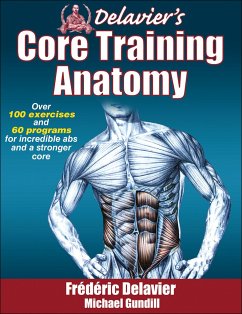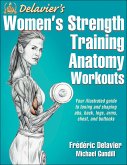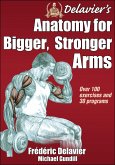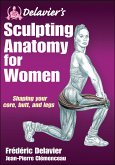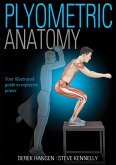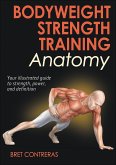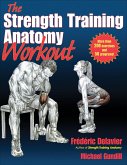23,99 €
inkl. MwSt.
Versandfertig in über 4 Wochen

12 °P sammeln
- Broschiertes Buch
- Merkliste
- Auf die Merkliste
- Bewerten Bewerten
- Teilen
- Produkt teilen
- Produkterinnerung
- Produkterinnerung
A guide to increasing core strength, stability and flexibility. Whether you're just beginning your routine or looking to enhance an existing conditioning programme, it features over 100 exercises and 60 programmes to show how muscles interact with surrounding joints and skeletal structures.
Andere Kunden interessierten sich auch für
![Delavier's Women's Strength Training Anatomy Workouts Delavier's Women's Strength Training Anatomy Workouts]() Frederic DelavierDelavier's Women's Strength Training Anatomy Workouts20,99 €
Frederic DelavierDelavier's Women's Strength Training Anatomy Workouts20,99 €![Delavier's Anatomy for Bigger, Stronger Arms Delavier's Anatomy for Bigger, Stronger Arms]() Frederic DelavierDelavier's Anatomy for Bigger, Stronger Arms20,99 €
Frederic DelavierDelavier's Anatomy for Bigger, Stronger Arms20,99 €![Delavier's Sculpting Anatomy for Women Delavier's Sculpting Anatomy for Women]() Frederic DelavierDelavier's Sculpting Anatomy for Women17,99 €
Frederic DelavierDelavier's Sculpting Anatomy for Women17,99 €![Plyometric Anatomy Plyometric Anatomy]() Derek HansenPlyometric Anatomy22,99 €
Derek HansenPlyometric Anatomy22,99 €![Bodyweight Strength Training Anatomy Bodyweight Strength Training Anatomy]() Bret ContrerasBodyweight Strength Training Anatomy19,99 €
Bret ContrerasBodyweight Strength Training Anatomy19,99 €![The Strength Training Anatomy Workout The Strength Training Anatomy Workout]() Frederic DelavierThe Strength Training Anatomy Workout24,99 €
Frederic DelavierThe Strength Training Anatomy Workout24,99 €![Delavier's Mixed Martial Arts Anatomy Delavier's Mixed Martial Arts Anatomy]() Frederic DelavierDelavier's Mixed Martial Arts Anatomy22,99 €
Frederic DelavierDelavier's Mixed Martial Arts Anatomy22,99 €-
-
-
A guide to increasing core strength, stability and flexibility. Whether you're just beginning your routine or looking to enhance an existing conditioning programme, it features over 100 exercises and 60 programmes to show how muscles interact with surrounding joints and skeletal structures.
Hinweis: Dieser Artikel kann nur an eine deutsche Lieferadresse ausgeliefert werden.
Hinweis: Dieser Artikel kann nur an eine deutsche Lieferadresse ausgeliefert werden.
Produktdetails
- Produktdetails
- Verlag: Human Kinetics Publishers
- Seitenzahl: 144
- Erscheinungstermin: 10. Oktober 2011
- Englisch
- Abmessung: 258mm x 197mm x 12mm
- Gewicht: 564g
- ISBN-13: 9781450413992
- ISBN-10: 1450413994
- Artikelnr.: 33649692
- Herstellerkennzeichnung
- Libri GmbH
- Europaallee 1
- 36244 Bad Hersfeld
- gpsr@libri.de
- Verlag: Human Kinetics Publishers
- Seitenzahl: 144
- Erscheinungstermin: 10. Oktober 2011
- Englisch
- Abmessung: 258mm x 197mm x 12mm
- Gewicht: 564g
- ISBN-13: 9781450413992
- ISBN-10: 1450413994
- Artikelnr.: 33649692
- Herstellerkennzeichnung
- Libri GmbH
- Europaallee 1
- 36244 Bad Hersfeld
- gpsr@libri.de
Frédéric Delavier is a gifted artist with an exceptional knowledge of human anatomy. He studied morphology and anatomy for five years at the prestigious École des Beaux-Arts in Paris and studied dissection for three years at the Paris Faculté de Médecine. The former editor in chief of the French magazine PowerMag, Delavier is currently a journalist for the French magazine Le Monde du Muscle and a contributor to several other muscle publications, including Men's Health Germany. He is the author of the best-selling Strength Training Anatomy, Women's Strength Training Anatomy, The Strength Training Anatomy Workout, and Delavier's Stretching Anatomy. Delavier won the French powerlifting title in 1988 and makes annual presentations on the sport applications of biomechanics at conferences in Switzerland. His teaching efforts have earned him the Grand Prix de Techniques et de Pédagogie Sportive. Delavier lives in Paris, France. Michael Gundill has written 13 books on strength training, sport nutrition, and health including co-authoring The Strength Training Anatomy Workout. His books have been translated into multiple languages, and he has written over 500 articles for bodybuilding and fitness magazines worldwide, including Iron Man and Dirty Dieting. In 1998 he won the Article of the Year Award at the Fourth Academy of Bodybuilding Fitness & Sports Awards in California. Gundill started weightlifting in 1983 in order to improve his rowing performance. Most of his training years were spent completing specific lifting programs in his home. As he gained muscle and refined his program, he began to learn more about physiology, anatomy, and biomechanics and started studying those subjects in medical journals. Since 1995 he has been writing about his discoveries in various bodybuilding and fitness magazines all over the world.
PART 1
20 Steps to Creating the Perfect Core Workout Program
1. Set your goals
2. How many workouts should you do each week?
3. On which days of the week should you exercise?
4. Should you exercise once or twice per day?
5. What time of day should you exercise?
6. How many sets should you do?
7. Be flexible and adaptable
8. How many exercises should you do for each muscle?
9. When should you change exercises?
10. How many repetitions should you do per set?
11. How quickly should you perform repetitions?
12. Adjust range of motion in the exercises
13. How long should a workout last?
14. How much rest time should you take between sets?
15. Determine the most appropriate weight for each exercise
16. When should you increase the weight?
17. Determine rest time between exercises
18. Learn to choose exercises that work for you
19. Know when to change your workout program
20. Taking a vacation?
Keep a Workout Notebook
Making Progress
PART 2
Increase the Visibility of Your Abs
Exercising Your Abs for a Smaller Waist
Intensity First!
Diet as a Way to Slim Your Waist
Diet Plus Workout Synergy
Improving the Effectiveness of Your Diet
Role of Supplements
BCAAs for Losing Belly Fat
Calcium: The Anti-Belly Fat Mineral
PART 3
Basic Exercises to Sculpt Your Abs
Anatomical Considerations
Beware of Fake Abdominal Exercises!
If You Have an Inguinal, Femoral, or Abdominal Hernia
Rectus Abdominis Exercises
Crunch
Lying Leg Raise
Seated Leg Raise
Oblique Exercises
Apollo's Belt
Twisting Crunch
Side Crunch
Stability Exercises
Static Stability Exercise, Back Against a Wall
Plank
Breathing Exercises to Improve Athletic Performance
Lying Rib Cage Expansion With a Weight
Diaphragm Contraction
Stretching the Abdominal Muscles
On a Stability Ball
Stretching the Hip Flexors
Tilting of the Pelvis
Abdominal-Lumbar Balance
Lunge
Stretches for the Low Back
Preventing Low Back Pain
Relaxation Stretch on a Stability Ball
Hanging From a Pull-Up Bar
PART 4
Advanced Exercises and Techniques
Three Difficulties of Ab Work
How to Isolate Upper Abdominal Work From Lower Abdominal Work
Why Are the Lower Abs So Hard to Develop?
1. It is difficult to recruit that part of the muscle
2. Lower abs lack strength
3. It is difficult to isolate the lower part
4. Lower abs are not robust
5. Some exercises are inappropriate
Three Zones of Attack for Total Development
Relative Importance of Each Zone
Getting a Head Start on Recovery
Exercises for the Upper Abdominal Muscles
Double Crunch
Sit-Up
Exercises for the Lower Abdominal Muscles
Pelvic Tilts on the Pull-Up Bar
Leg Lift
Hanging Leg Raise
Exercises for the Obliques
Hanging Leg Raise to the Side
Lying Twist
PART 5
Ab and Core Exercises Using Machines and Accessories
Purpose of Home Equipment
Professional Machines
Exercises for the Upper Abdominal Muscles
Crunch Machines
Swiss Ball Crunch
Rocking Machine Crunch
Standing Cable Crunch
Exercises for the Lower Abdominal Muscles
Ab Coaster
Exercises for the Obliques
Cable Twist (or Using a Machine)
Side Bend
PART 6
Workout Programs for Abdominal and Core Muscles
Six-Pack Programs
Beginning Programs
Advanced Programs
Very Advanced Programs
At-Home Programs Using Accessories
Programs Using Equipment in a Gym
Programs to Reduce Belly Fat
Programs to Reduce Love Handles
Programs to Highlight Apollo's Belt
Programs for Well-Being
Programs for Cardiovascular Health
Programs to Relax Your Back Before Sleep
Programs to Help Protect Your Lumbar Spine
Programs to Help With Bloating and Other Digestive Problems
Sport-Specific Core Programs
Phase 1: Basic Muscle Conditioning Programs for Beginners
Phase 2: Working Toward Circuit Training
Phase 3: Workouts to Improve Overall Physical Qualities
Phase 4: Working Toward More Specific Training
20 Steps to Creating the Perfect Core Workout Program
1. Set your goals
2. How many workouts should you do each week?
3. On which days of the week should you exercise?
4. Should you exercise once or twice per day?
5. What time of day should you exercise?
6. How many sets should you do?
7. Be flexible and adaptable
8. How many exercises should you do for each muscle?
9. When should you change exercises?
10. How many repetitions should you do per set?
11. How quickly should you perform repetitions?
12. Adjust range of motion in the exercises
13. How long should a workout last?
14. How much rest time should you take between sets?
15. Determine the most appropriate weight for each exercise
16. When should you increase the weight?
17. Determine rest time between exercises
18. Learn to choose exercises that work for you
19. Know when to change your workout program
20. Taking a vacation?
Keep a Workout Notebook
Making Progress
PART 2
Increase the Visibility of Your Abs
Exercising Your Abs for a Smaller Waist
Intensity First!
Diet as a Way to Slim Your Waist
Diet Plus Workout Synergy
Improving the Effectiveness of Your Diet
Role of Supplements
BCAAs for Losing Belly Fat
Calcium: The Anti-Belly Fat Mineral
PART 3
Basic Exercises to Sculpt Your Abs
Anatomical Considerations
Beware of Fake Abdominal Exercises!
If You Have an Inguinal, Femoral, or Abdominal Hernia
Rectus Abdominis Exercises
Crunch
Lying Leg Raise
Seated Leg Raise
Oblique Exercises
Apollo's Belt
Twisting Crunch
Side Crunch
Stability Exercises
Static Stability Exercise, Back Against a Wall
Plank
Breathing Exercises to Improve Athletic Performance
Lying Rib Cage Expansion With a Weight
Diaphragm Contraction
Stretching the Abdominal Muscles
On a Stability Ball
Stretching the Hip Flexors
Tilting of the Pelvis
Abdominal-Lumbar Balance
Lunge
Stretches for the Low Back
Preventing Low Back Pain
Relaxation Stretch on a Stability Ball
Hanging From a Pull-Up Bar
PART 4
Advanced Exercises and Techniques
Three Difficulties of Ab Work
How to Isolate Upper Abdominal Work From Lower Abdominal Work
Why Are the Lower Abs So Hard to Develop?
1. It is difficult to recruit that part of the muscle
2. Lower abs lack strength
3. It is difficult to isolate the lower part
4. Lower abs are not robust
5. Some exercises are inappropriate
Three Zones of Attack for Total Development
Relative Importance of Each Zone
Getting a Head Start on Recovery
Exercises for the Upper Abdominal Muscles
Double Crunch
Sit-Up
Exercises for the Lower Abdominal Muscles
Pelvic Tilts on the Pull-Up Bar
Leg Lift
Hanging Leg Raise
Exercises for the Obliques
Hanging Leg Raise to the Side
Lying Twist
PART 5
Ab and Core Exercises Using Machines and Accessories
Purpose of Home Equipment
Professional Machines
Exercises for the Upper Abdominal Muscles
Crunch Machines
Swiss Ball Crunch
Rocking Machine Crunch
Standing Cable Crunch
Exercises for the Lower Abdominal Muscles
Ab Coaster
Exercises for the Obliques
Cable Twist (or Using a Machine)
Side Bend
PART 6
Workout Programs for Abdominal and Core Muscles
Six-Pack Programs
Beginning Programs
Advanced Programs
Very Advanced Programs
At-Home Programs Using Accessories
Programs Using Equipment in a Gym
Programs to Reduce Belly Fat
Programs to Reduce Love Handles
Programs to Highlight Apollo's Belt
Programs for Well-Being
Programs for Cardiovascular Health
Programs to Relax Your Back Before Sleep
Programs to Help Protect Your Lumbar Spine
Programs to Help With Bloating and Other Digestive Problems
Sport-Specific Core Programs
Phase 1: Basic Muscle Conditioning Programs for Beginners
Phase 2: Working Toward Circuit Training
Phase 3: Workouts to Improve Overall Physical Qualities
Phase 4: Working Toward More Specific Training
PART 1
20 Steps to Creating the Perfect Core Workout Program
1. Set your goals
2. How many workouts should you do each week?
3. On which days of the week should you exercise?
4. Should you exercise once or twice per day?
5. What time of day should you exercise?
6. How many sets should you do?
7. Be flexible and adaptable
8. How many exercises should you do for each muscle?
9. When should you change exercises?
10. How many repetitions should you do per set?
11. How quickly should you perform repetitions?
12. Adjust range of motion in the exercises
13. How long should a workout last?
14. How much rest time should you take between sets?
15. Determine the most appropriate weight for each exercise
16. When should you increase the weight?
17. Determine rest time between exercises
18. Learn to choose exercises that work for you
19. Know when to change your workout program
20. Taking a vacation?
Keep a Workout Notebook
Making Progress
PART 2
Increase the Visibility of Your Abs
Exercising Your Abs for a Smaller Waist
Intensity First!
Diet as a Way to Slim Your Waist
Diet Plus Workout Synergy
Improving the Effectiveness of Your Diet
Role of Supplements
BCAAs for Losing Belly Fat
Calcium: The Anti-Belly Fat Mineral
PART 3
Basic Exercises to Sculpt Your Abs
Anatomical Considerations
Beware of Fake Abdominal Exercises!
If You Have an Inguinal, Femoral, or Abdominal Hernia
Rectus Abdominis Exercises
Crunch
Lying Leg Raise
Seated Leg Raise
Oblique Exercises
Apollo's Belt
Twisting Crunch
Side Crunch
Stability Exercises
Static Stability Exercise, Back Against a Wall
Plank
Breathing Exercises to Improve Athletic Performance
Lying Rib Cage Expansion With a Weight
Diaphragm Contraction
Stretching the Abdominal Muscles
On a Stability Ball
Stretching the Hip Flexors
Tilting of the Pelvis
Abdominal-Lumbar Balance
Lunge
Stretches for the Low Back
Preventing Low Back Pain
Relaxation Stretch on a Stability Ball
Hanging From a Pull-Up Bar
PART 4
Advanced Exercises and Techniques
Three Difficulties of Ab Work
How to Isolate Upper Abdominal Work From Lower Abdominal Work
Why Are the Lower Abs So Hard to Develop?
1. It is difficult to recruit that part of the muscle
2. Lower abs lack strength
3. It is difficult to isolate the lower part
4. Lower abs are not robust
5. Some exercises are inappropriate
Three Zones of Attack for Total Development
Relative Importance of Each Zone
Getting a Head Start on Recovery
Exercises for the Upper Abdominal Muscles
Double Crunch
Sit-Up
Exercises for the Lower Abdominal Muscles
Pelvic Tilts on the Pull-Up Bar
Leg Lift
Hanging Leg Raise
Exercises for the Obliques
Hanging Leg Raise to the Side
Lying Twist
PART 5
Ab and Core Exercises Using Machines and Accessories
Purpose of Home Equipment
Professional Machines
Exercises for the Upper Abdominal Muscles
Crunch Machines
Swiss Ball Crunch
Rocking Machine Crunch
Standing Cable Crunch
Exercises for the Lower Abdominal Muscles
Ab Coaster
Exercises for the Obliques
Cable Twist (or Using a Machine)
Side Bend
PART 6
Workout Programs for Abdominal and Core Muscles
Six-Pack Programs
Beginning Programs
Advanced Programs
Very Advanced Programs
At-Home Programs Using Accessories
Programs Using Equipment in a Gym
Programs to Reduce Belly Fat
Programs to Reduce Love Handles
Programs to Highlight Apollo's Belt
Programs for Well-Being
Programs for Cardiovascular Health
Programs to Relax Your Back Before Sleep
Programs to Help Protect Your Lumbar Spine
Programs to Help With Bloating and Other Digestive Problems
Sport-Specific Core Programs
Phase 1: Basic Muscle Conditioning Programs for Beginners
Phase 2: Working Toward Circuit Training
Phase 3: Workouts to Improve Overall Physical Qualities
Phase 4: Working Toward More Specific Training
20 Steps to Creating the Perfect Core Workout Program
1. Set your goals
2. How many workouts should you do each week?
3. On which days of the week should you exercise?
4. Should you exercise once or twice per day?
5. What time of day should you exercise?
6. How many sets should you do?
7. Be flexible and adaptable
8. How many exercises should you do for each muscle?
9. When should you change exercises?
10. How many repetitions should you do per set?
11. How quickly should you perform repetitions?
12. Adjust range of motion in the exercises
13. How long should a workout last?
14. How much rest time should you take between sets?
15. Determine the most appropriate weight for each exercise
16. When should you increase the weight?
17. Determine rest time between exercises
18. Learn to choose exercises that work for you
19. Know when to change your workout program
20. Taking a vacation?
Keep a Workout Notebook
Making Progress
PART 2
Increase the Visibility of Your Abs
Exercising Your Abs for a Smaller Waist
Intensity First!
Diet as a Way to Slim Your Waist
Diet Plus Workout Synergy
Improving the Effectiveness of Your Diet
Role of Supplements
BCAAs for Losing Belly Fat
Calcium: The Anti-Belly Fat Mineral
PART 3
Basic Exercises to Sculpt Your Abs
Anatomical Considerations
Beware of Fake Abdominal Exercises!
If You Have an Inguinal, Femoral, or Abdominal Hernia
Rectus Abdominis Exercises
Crunch
Lying Leg Raise
Seated Leg Raise
Oblique Exercises
Apollo's Belt
Twisting Crunch
Side Crunch
Stability Exercises
Static Stability Exercise, Back Against a Wall
Plank
Breathing Exercises to Improve Athletic Performance
Lying Rib Cage Expansion With a Weight
Diaphragm Contraction
Stretching the Abdominal Muscles
On a Stability Ball
Stretching the Hip Flexors
Tilting of the Pelvis
Abdominal-Lumbar Balance
Lunge
Stretches for the Low Back
Preventing Low Back Pain
Relaxation Stretch on a Stability Ball
Hanging From a Pull-Up Bar
PART 4
Advanced Exercises and Techniques
Three Difficulties of Ab Work
How to Isolate Upper Abdominal Work From Lower Abdominal Work
Why Are the Lower Abs So Hard to Develop?
1. It is difficult to recruit that part of the muscle
2. Lower abs lack strength
3. It is difficult to isolate the lower part
4. Lower abs are not robust
5. Some exercises are inappropriate
Three Zones of Attack for Total Development
Relative Importance of Each Zone
Getting a Head Start on Recovery
Exercises for the Upper Abdominal Muscles
Double Crunch
Sit-Up
Exercises for the Lower Abdominal Muscles
Pelvic Tilts on the Pull-Up Bar
Leg Lift
Hanging Leg Raise
Exercises for the Obliques
Hanging Leg Raise to the Side
Lying Twist
PART 5
Ab and Core Exercises Using Machines and Accessories
Purpose of Home Equipment
Professional Machines
Exercises for the Upper Abdominal Muscles
Crunch Machines
Swiss Ball Crunch
Rocking Machine Crunch
Standing Cable Crunch
Exercises for the Lower Abdominal Muscles
Ab Coaster
Exercises for the Obliques
Cable Twist (or Using a Machine)
Side Bend
PART 6
Workout Programs for Abdominal and Core Muscles
Six-Pack Programs
Beginning Programs
Advanced Programs
Very Advanced Programs
At-Home Programs Using Accessories
Programs Using Equipment in a Gym
Programs to Reduce Belly Fat
Programs to Reduce Love Handles
Programs to Highlight Apollo's Belt
Programs for Well-Being
Programs for Cardiovascular Health
Programs to Relax Your Back Before Sleep
Programs to Help Protect Your Lumbar Spine
Programs to Help With Bloating and Other Digestive Problems
Sport-Specific Core Programs
Phase 1: Basic Muscle Conditioning Programs for Beginners
Phase 2: Working Toward Circuit Training
Phase 3: Workouts to Improve Overall Physical Qualities
Phase 4: Working Toward More Specific Training
